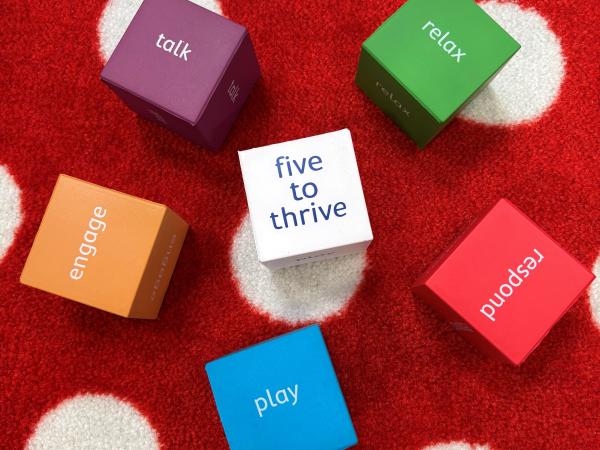What is Five to Thrive
Humans are born to connect and care. Right from our first breath, every human needs safe connections with people who care about them - our caregivers.
Five to Thrive describes the neurological sequence of activity that caregivers produce whenever they meet the needs of others.
Five to Thrive is a model which enables us to notice what goes on in interactions between people.
Five to Thrive is an approach which enables us to be a meeter-of-needs in our interactions with other people. As humans, people need people.
Five to Thrive is a framework which enables us to teach others about the part they play in brain development
Many things can get in the way of connected relationships between people such as illness, disability, pain or stress, physical or mental illness, domestic violence, substance misuse etc.
The Building Blocks - The Neurological Sequence
When we read the blocks from bottom to top, it explains the neurological sequence our brain goes through when we can offer co-regulation to others.
Five to Thrive is part of our normal behaviour as long as we're feeling regulated, grounded, and resilient enough.
We are not telling people what to do because we are already being Five to Thrive by virtue of being human, but as with anything the more we understand it, and notice how we behave (or parent) on our best days, then the more we will feel inspired to do it again.
It's also important to recognise when we ourselves need support and who can help us when we notice our own tower may not feel as stable as usual. We're not able to help co-regulate other people if we're feeling dis-regulated. The five ways to good wellbeing idea can help with this.

Ask yourself these questions to build your own support network when your batteries need a boost
RESPOND - Who responds to you when you feel anxious or unsafe?
ENGAGE - Who is good at engaging with you?
RELAX - Who co-regulates with you?
PLAY - Whose playfulness helps your brain to work?
TALK - Whose narrative helps you make sense of things?
The Building Blocks - Activities
Along with the neurological sequence supporting self/co regulation, the building blocks can also be used to describe activities a family can do at home. Each block has brain building potential.
Training Videos - How Five to Thrive can be used throughout the ages 0-25
Baby
Toddler
Primary School
Secondary School
Neurodiverse Young Adult
Downloadable Resources
Five to Thrive postcard (with QR code)
Five to Thrive overview for parents
Five to Thrive observation check list
Five to Thrive Workbook for one to one work
Mending Hurts Workbook for one to one work
Parent Journal - A handy guide for parents to track their Five to Thrive Journey
Five to Thrive insert for Red Book (Personal healthcare book)
Teen Journal - To use with older children to help them recognise the building blocks and which maybe missing
Make your own building blocks
Five to Thrive Drop Cards - handy quotes, key features of each block and images
Reflective Practice
Five to Thrive has helped parents break down their interactions with their children and helped them step back and reflect on their parenting style and how to approach a child. It has also helped them to understand how they need to be balanced within themselves to be able to give their full support to their child.
It has given families the understanding of importance of all the different blocks individually of how to support their babies brain to develop to its fullest potential. It has also helped to support them with play ideas to develop their babies brain and recognise its things they are already doing.
Five to Thrive is a peg within the pathway and its integrated throughout the whole 2 years through play and setting up a range of activities that support babies brain development but it is also about the interactions parents have with their babies and interactions they have with other parents and practitioners.
Emily - Family Wellbeing Worker, LCC
As a CSA in Family Hubs, the Five to Thrive model comes in to play when we have any interaction with users of our buildings. People come into our Hubs from a range of backgrounds and for many different reasons.
One common thing we might see are parents that feel nervous or anxious about attending a group such as 0-2 Pathway for the first time. As a CSA we recognise the need for co-regulation so they feel supported and valued.
I'd RESPOND in a welcoming way, ENGAGE with eye contact for reassurance, RELAX by staying calm and making the environment peaceful, be PLAYFUL by being friendly and TALK with them so they feel comfortable
Lucy, Centre Support Assistant Family Hubs LeicestershireIf you'd like to share how Five to Thrive has supported either yourself, child, family, group you've been working with please email familyhubs@leics.gov.uk
Communication
Social Media
Here is an example of a 7 day Facebook comms plan to introduce the building blocks to families. The images used were from the downloadable drop card and images from the Five to Thrive page
Best Practice Ideas
Group Work for 0-5
Here's a 3 week session plan (can merge together if the session is long enough) if you were running a Five to Thrive group like a parent class or pathway
One to One Work (any age)
These useful practitioner workbooks will help you plan a Five to Thrive session and a Mending Hurts (trauma recovery/maintenance) session effectively. It includes a summary of the approach, possible questions and a log for you to record what's discussed to follow up if required
Activities & Games
Cut out these quotes and mix them up. Ask your parent/family/group/colleague to say which block they correspond with.
You can make your own Five to Thrive blocks by downloading the template below
Scenarios Five to Thrive can help with
Five to Thrive can be applied to almost every scenario because it's based on humans needing relationships and connections. See a few examples below
How can Five to Thrive help a parent with an autistic child
How can Five to Thrive help a parent with a non verbal child
How can Five to Thrive support after school pick up
How can Five to Thrive support a family with the emotions of financial worries
How can Five to Thrive support mental health challenges
How can Five to Thrive support school anxiety
How can Five to Thrive support a person with limited English
How can Five to Thrive support children with disrupted sleep
How can Five to Thrive support therapeutic support
The Building Blocks - Summary

Block 1: Respond:
Responding involves tuning into another person’s emotions, accepting their stress, and helping them regulate it. Barriers to responsiveness include stress and distractions, which can make individuals feel ignored or unsupported. Recognising and valuing responsiveness in ourselves and others is crucial. If children’s need for responsive interactions isn’t met, they may struggle with identity, safety, bonding, and emotional regulation. Adults can support children by learning their unique cues, being patient even when met with hostility, and making connections with trusted adults to create a sense of security.
Block 2 - Engage:
Engagement is key to connection and co-regulation, requiring awareness of physical proximity, eye contact, posture, and voice tone. Observing and understanding engagement helps identify when someone is connected or withdrawn. Adults can support engagement by adjusting their approach—using different positions, tones, or levels of interaction to find what comforts rather than overwhelms. If engagement needs aren’t met, children may struggle with recognising emotions, social motivation, and empathy. Teaching others about engagement’s importance ensures children receive the support they need to build meaningful connections.
Block 3 – Relax:
Relaxation is essential for emotional balance and effective brain function. Throughout life, we rely on others to help us regulate stress through co-regulation. As co-regulators, we must first calm ourselves, allowing the other person to relax. Self-regulation strategies include adjusting posture, deep breathing, movement, and changing thoughts. If children’s regulation needs aren’t met, they may experience hyperarousal, reduced concentration, or dissociation. Adults can support regulation by consciously staying calm, matching a child’s emotional state, and then guiding them to self-regulate. Teaching others about co-regulation ensures stronger emotional resilience in children and families.
Block 4 – Play:
Play activates the social and emotional brain through non-verbal communication, such as facial expressions, body language, and gestures. This type of interaction allows the co-regulator to connect on an emotional level, helping the other person understand and process emotions more effectively. Non-verbal cues enable a reciprocal give-and-take of engagement, relaxation, and responding, which promotes emotional connection and understanding. Practicing playful, non-verbal communication through activities like mirroring helps build social skills and emotional regulation. If children’s needs aren’t met in play, they may struggle with reciprocity, cooperation, or managing emotions like shame. Adults can support children by being mindful of their non-verbal communication and practicing playfulness to foster healthy connections.
Block 5 – Talk:
Talk activates the cognitive and rational brain through verbal communication. From the moment babies are born, the words used by adults—whether during play, engagement, relaxation, or responsiveness—help shape their developing brain. What is said to a child, especially during moments of overwhelm, can have a lasting impact. Adults need to listen empathetically, speak honestly, and stay consistent even when the other person seems unresponsive. Positive verbal interactions, including storytelling, repetition, and checking comprehension, help children develop thinking, language, and communication skills. When these needs aren’t met, children may struggle with understanding speech, distinguishing between reality and fantasy, or managing time. Adults can support children by building language skills, using simple, clear language, and checking for understanding.
Training Events
We’re offering free Five to Thrive training for services across Leicester, Leicestershire, and Rutland. This training is in partnership with Family Hubs Leicestershire and Family Help Leicestershire County Council
What is Five to Thrive?
We’ve all heard that our body needs five portions of fruit and veg a day to stay healthy, but our brains need five things too. This simple, evidence-based approach focuses on five building blocks: Respond, Cuddle, Relax, Play, Talk. These help children feel safe, connected, and supported.
In turn, this emotional resilience will support their overall development in settings and at home, improving GLD outcomes, school readiness and support good mental health.
Why is it important?
- Builds secure relationships between children and trusted adults (with focus on having a support network outside of the family home)
- Helps recovery from trauma, manage big feelings and understand why self-regulation is important for everyone
- Gives practitioners a shared language and collaboration approach to work together with the wider Early Help teams
- Makes every contact count by improving engagement with families through encouraging positive parenting and role modelling
- Helping practitioners recognise their role as a vital resource for families
Book Your Place
- 11th December, 4–6pm Register here
- 14th January, 10am–12pm Register here


